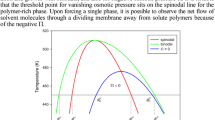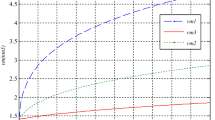Abstract
The osmotic pressures of polymer solutions are related to their corresponding osmotic virial coefficients. There are several experimental methods to determine the osmotic virial coefficients. However, these experimental virial coefficients are restricted to the experimental conditions. An alternative way of determining the osmotic virial coefficient is with the help of statistical thermodynamics, and unlike experimental methods, because of its theoretical basis, it is not restricted to limited ranges of experimental conditions. The osmotic virial coefficients can be used to calculate the different properties of polymers and polymer solutions, such as the average molecular weight of the polymer (M) and the theta temperature. In this work, for the first time, the second osmotic virial coefficients of a number of polymeric solutions are calculated using the Kihara and Exponential-6 intermolecular potential functions. Furthermore, the hard-core Exponential-6 model, that we have proposed, is also investigated. Additionally, the molecular weights and theta temperatures of these solutions are determined using the calculated second virial coefficients and are compared to literature data. The results show that the recent hard-core Exponential-6 potential model is more accurate than the Kihara and Exponential-6 models and is applicable for calculating other properties of the polymers and polymer solutions.



Similar content being viewed by others
References
Utracki LA, Wilkie CA (2014) Polymer blends handbook, 2nd edn. Springer, Dordrecht
Striolo A, Prausnitz JM (2000) Osmotic second virial cross coefficients for star and linear polystyrenes. J Chem Phys 113(7):2927–2931. https://doi.org/10.1063/1.1305888
Norisuye T, Nakamura Y, Akasaka K (1993) Reduced third virial coefficient for linear flexible polymers in good solvents. Macromolecules 26(15):3791–3794. https://doi.org/10.1021/ma00067a011
Wohlfarth C (2010) Polymer solutions: physical properties and their relations I (thermodynamic properties: PVT data and miscellaneous properties of polymer solutions), vol 6. Springer, Berlin
Koyama R (1959) The second virial coefficient of polymer solutions. J Polym Sci 35(128):247–258. https://doi.org/10.1002/pol.1959.1203512820
Poling BE, Prausnitz JM, O’Connell JP (2001) The properties of gases and liquids, 5th edn. McGraw-Hill, New York
Stockmayer WH, Casassa EF (1952) The third virial coefficient in polymer solutions. J Chem Phys 20(10):1560–1566. https://doi.org/10.1063/1.1700216
Caracciolo S, Mognetti BM, Pelissetto A (2006) Virial coefficients and osmotic pressure in polymer solutions in good-solvent conditions. J Chem Phys 125(9):094903. https://doi.org/10.1063/1.2338913
Ersch C, Meijvogel LLC, van der Linden E, Martin A, Venema P (2016) Interactions in protein mixtures. Part I: second virial coefficients from osmometry. Food Hydrocolloids 52:982–990. https://doi.org/10.1016/j.foodhyd.2015.07.020
Ersch C, van der Linden E, Martin A, Venema P (2016) Interactions in protein mixtures. Part II: a virial approach to predict phase behavior. Food Hydrocolloids 52:991–1002. https://doi.org/10.1016/j.foodhyd.2015.07.021
Schleinitz M, Teschner D, Sadowski G, Brandenbusch C (2019) Second osmotic virial coefficients of therapeutic proteins in the presence of excipient-mixtures can be predicted to aid an efficient formulation design. J Mol Liq 283:575–583. https://doi.org/10.1016/j.molliq.2019.03.064
Matsumura K (1970) Solution behaviour of poly(o-chlorostyrene). Polym J 1(3):322–326. https://doi.org/10.1295/polymj.1.322
Lu W, Yin P, Osa M, Wang W, Kang N-G, Hong K, Mays JW (2017) Solution properties, unperturbed dimensions, and chain flexibility of poly(1-adamantyl acrylate). J Polym Sci Part B Polym Phys 55(20):1526–1531. https://doi.org/10.1002/polb.24408
Moses CL, Van Hook WA (2003) Pressure dependence of the second virial coefficient of dilute polystyrene solutions. J Polym Sci Part B Polym Phys 41(23):3070–3076. https://doi.org/10.1002/polb.10620
Szydlowski J, Van Hook WA (2001) Osmotic compressibility in dilute polystyrene-cyclohexane and polystyrene-methylcyclohexane solutions: correlation of polystyrene virial coefficients with solvent quality. J Polym Sci Part B Polym Phys 39(1):184–196. https://doi.org/10.1002/1099-0488(20010101)39:1<184::AID-POLB170>3.0.CO;2-X
Oohashi T, Inoue K, Nakamura Y (2014) Second and third virial coefficients of low-molecular-weight polyisoprene in 1,4-dioxane. Polym J 46:699–703. https://doi.org/10.1038/pj.2014.43
Peyrovedin H, Shariati A (2018) A hard-core Exp-6 intermolecular potential function for determining virial coefficients of pure nonpolar and slightly-polar molecules. Fluid Phase Equilib 459:103–109. https://doi.org/10.1016/j.fluid.2017.12.003
Rudin A (1999) The elements of polymer science and engineering, 2nd edn. Academic Press, Boston
Isihara A, Koyama R (1956) Theory of dilute high-polymer solutions (the Pearl Necklace model). J Chem Phys 25(4):712–716. https://doi.org/10.1063/1.1743034
Kihara T (1955) Virial coefficients and models of molecules in gases. B. Rev Mod Phys 27(4):412–423. https://doi.org/10.1103/RevModPhys.27.412
Kihara T (1953) Virial coefficients and models of molecules in gases. Rev Mod Phys 25(4):831–843. https://doi.org/10.1103/RevModPhys.25.831
Mason EA (1954) Transport properties of gases obeying a modified buckingham (Exp-Six) potential. J Chem Phys 22(2):169–186. https://doi.org/10.1063/1.1740026
Prausnitz JM, Lichtenthaler RN, Azevedo E (1999) Molecular thermodynamics of fluid-phase equilibria, 3rd edn. Prentice Hall PTR, Upper Saddle River, NJ
Matsumoto T, Nishioka N, Fujita H (1972) Excluded-volume effects in dilute polymer solutions. IV. Polyisobutylene. J Polym Sci Part B Polym Phys 10(1):23–42. https://doi.org/10.1002/pol.1972.160100103
Gundert F, Wolf BA (1987) On the molecular weight dependence of the thermodynamic and of the hydrodynamic pair interaction between chain molecules. IV. Second virial coefficients revisited. J Chem Phys 87(10):6156–6165. https://doi.org/10.1063/1.453491
Ho-Duc N, Daoust H, Blssonnette F (1972) Etude de propriétés hydrodynamiques de solutions de polymères en mauvais solvants. Can J Chem 50(3):305–309. https://doi.org/10.1139/v72-045
Huglin MB, Khorasani MKH, Sasia PM (1988) Interpenetration functions and excluded-volume theories in relation to light scattering data from poly(phenyl acrylate) solutions. Polymer 29(9):1590–1593. https://doi.org/10.1016/0032-3861(88)90267-4
Allen G, Booth C, Price C (1966) The dilute solution properties of poly(propylene oxide). Polymer 7(4):167–175. https://doi.org/10.1016/0032-3861(66)90010-3
Yamakawa H, Abe F, Einaga Y (1994) Second virial coefficient of Oligo- and Polystyrenes near the.THETA. temperature. More on the coil-to-globule transition. Macromolecules 27(20):5704–5712. https://doi.org/10.1021/ma00098a026
Cantow HJ, Schuster RH (1982) Thermodynamics of macromolecular systems. Polym Bull 8(5):225–231. https://doi.org/10.1007/BF00700282
Orofino TA, Mickey JW (1963) Dilute solution properties of linear polystyrene IN Θ-solvent media. J Chem Phys 38(10):2512–2520. https://doi.org/10.1063/1.1733534
Yamamoto A, Fujii M, Tanaka G, Yamakawa H (1971) More on the analysis of dilute solution data: polystyrenes prepared anionically in tetrahydrofuran. Polym J 2(6):799–811. https://doi.org/10.1295/polymj.2.799
Kajiwara K, Ross-Murphy SB (1975) Computer analysis of light scattering data—I: polystyrene-cyclohexane system. Eur Polym J 11(5):365–376. https://doi.org/10.1016/0014-3057(75)90017-8
Lechner M, Schulz GV (1970) Lichtstreuung von hochmolekularen lösungen in abhängigkeit von temperatur und druck. Eur Polym J 6(7):945–957. https://doi.org/10.1016/0014-3057(70)90029-7
Nicolai T, Brown W (1996) Cooperative diffusion of concentrated polymer solutions: a static and dynamic light scattering study of polystyrene in DOP. Macromolecules 29(5):1698–1704. https://doi.org/10.1021/ma946430p
Acknowledgements
The authors would like to show their gratitude to Shiraz University for providing computer facilities.
Author information
Authors and Affiliations
Corresponding author
Additional information
Publisher's Note
Springer Nature remains neutral with regard to jurisdictional claims in published maps and institutional affiliations.
Rights and permissions
About this article
Cite this article
Peyrovedin, H., Khorram, M. & Shariati, A. Application of hard-core Exponential-6 intermolecular potential function to determine the second osmotic virial coefficients of polymer solutions. Polym. Bull. 78, 931–950 (2021). https://doi.org/10.1007/s00289-020-03141-3
Received:
Revised:
Accepted:
Published:
Issue Date:
DOI: https://doi.org/10.1007/s00289-020-03141-3




